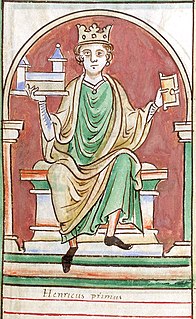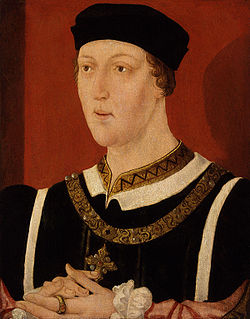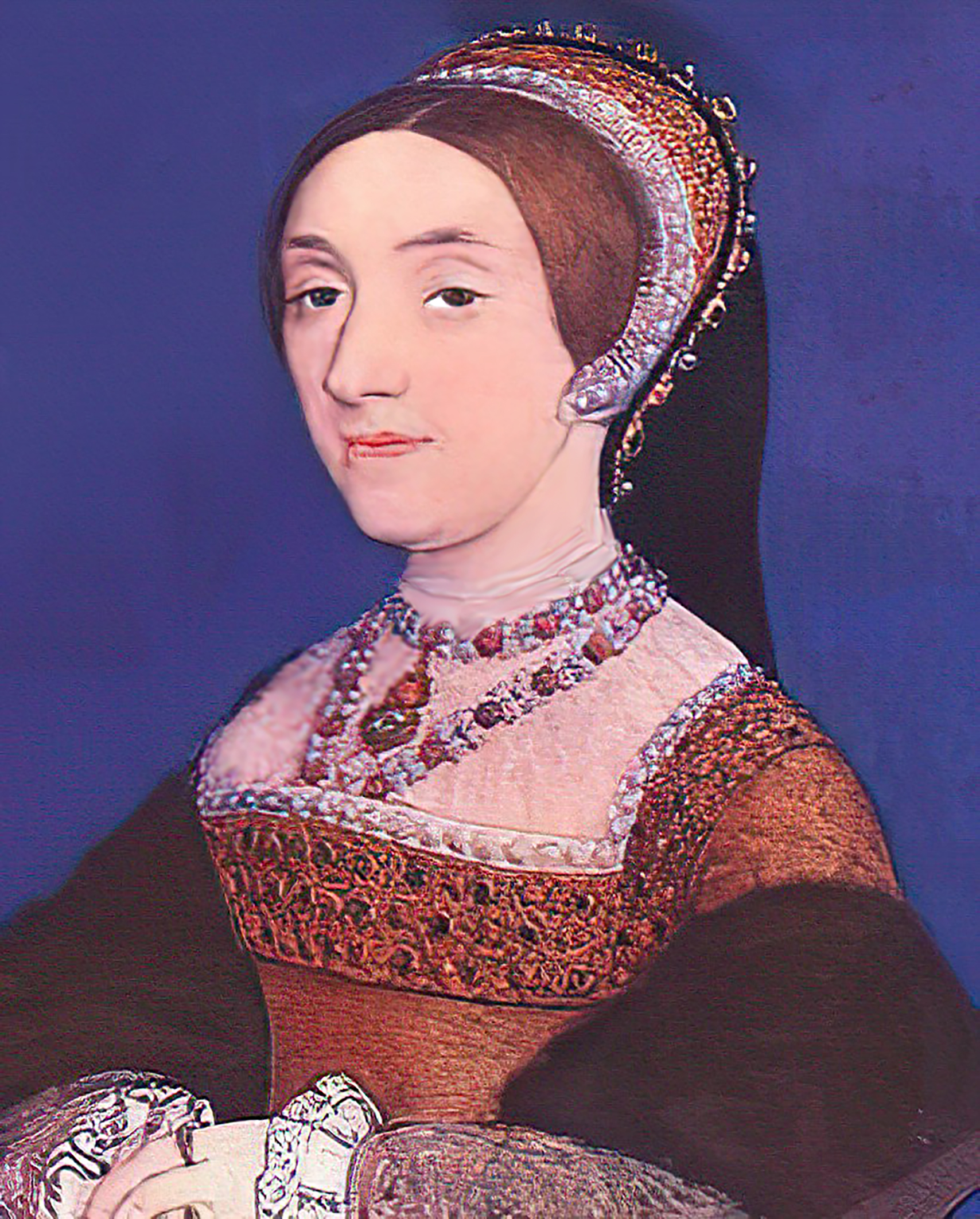Related Research Articles

Henry I, also known as Henry Beauclerc, was King of England from 1100 to his death in 1135. Henry was the fourth son of William the Conqueror and was educated in Latin and the liberal arts. On William's death in 1087, Henry's elder brothers Robert Curthose and William Rufus inherited Normandy and England, respectively, but Henry was left landless. Henry purchased the County of Cotentin in western Normandy from Robert, but William and Robert deposed him in 1091. Henry gradually rebuilt his power base in the Cotentin and allied himself with William against Robert. Henry was present when William died in a hunting accident in 1100, and he seized the English throne, promising at his coronation to correct many of William's less popular policies. Henry married Matilda of Scotland but continued to have a large number of mistresses by whom he had many illegitimate children.

Henry VII was the King of England and Lord of Ireland from his seizure of the crown on 22 August 1485 to his death on 21 April 1509. He was the first monarch of the House of Tudor.

Henry VIII was King of England from 1509 until his death in 1547. Henry was the second Tudor monarch, succeeding his father, Henry VII. Henry is best known for his six marriages, in particular his efforts to have his first marriage, to Catherine of Aragon, annulled. His disagreement with the Pope on the question of such an annulment led Henry to initiate the English Reformation, separating the Church of England from papal authority. He appointed himself the Supreme Head of the Church of England and dissolved convents and monasteries, for which he was excommunicated. Henry is also known as "the father of the Royal Navy"; he invested heavily in the Navy, increasing its size greatly from a few to more than 50 ships.

Anne Boleyn was Queen of England from 1533 to 1536 as the second wife of King Henry VIII. Henry's marriage to her, and her execution by beheading, made her a key figure in the political and religious upheaval that was the start of the English Reformation. Anne was the daughter of Thomas Boleyn, 1st Earl of Wiltshire, and his wife, Lady Elizabeth Howard, and was educated in the Netherlands and France, largely as a maid of honour to Queen Claude of France. Anne returned to England in early 1522, to marry her Irish cousin James Butler, 9th Earl of Ormond; the marriage plans were broken off, and instead she secured a post at court as maid of honour to Henry VIII's wife, Catherine of Aragon.

Henry V, also called Henry of Monmouth, was King of England from 1413 until his early death in 1422. He was the second English monarch of the House of Lancaster. Despite his relatively short reign, Henry's outstanding military successes in the Hundred Years' War against France, most notably in his famous victory at the Battle of Agincourt in 1415, made England one of the strongest military powers in Europe. Immortalised in the plays of Shakespeare, Henry is known and celebrated as one of the great warrior kings of medieval England.

Jane Seymour was Queen of England from 1536 to 1537 as the third wife of King Henry VIII. She succeeded Anne Boleyn as queen consort following the latter's execution in May 1536. She died of postnatal complications less than two weeks after the birth of her only child, a son who became King Edward VI. She was the only one of Henry's wives to receive a queen's funeral, and his only consort to be buried beside him in St George's Chapel, Windsor Castle.

Henry VI was King of England from 1422 to 1461 and again from 1470 to 1471, and disputed King of France from 1422 to 1453. The only child of Henry V, he succeeded to the English throne at the age of nine months upon his father's death, and succeeded to the French throne on the death of his maternal grandfather Charles VI shortly afterwards.

Henry IV, also known as Henry Bolingbroke, was King of England from 1399 to 1413, and asserted the claim of his grandfather, Edward III, to the Kingdom of France.
Henry the Lion was a member of the Welf dynasty and Duke of Saxony, as Henry III, from 1142, and Duke of Bavaria, as Henry XII, from 1156, the duchies of which he held until 1180.
The Henry Draper Catalogue (HD) is an astronomical star catalogue published between 1918 and 1924, giving spectroscopic classifications for 225,300 stars; it was later expanded by the Henry Draper Extension (HDE), published between 1925 and 1936, which gave classifications for 46,850 more stars, and by the Henry Draper Extension Charts (HDEC), published from 1937 to 1949 in the form of charts, which gave classifications for 86,933 more stars. In all, 359,083 stars were classified as of August 2017.

Thierry Daniel Henry is a French professional football coach and former player who was most recently the manager of Ligue 1 club Monaco.
In chemistry, Henry's law is a gas law that states that the amount of dissolved gas in liquid is proportional to its partial pressure above the liquid. The proportionality factor is called the Henry's law constant. It was formulated by the English chemist William Henry, who studied the topic in the early 19th century. In his publication about the quantity of gases absorbed by water, he described the results of his experiments:

John Henry is an African American folk hero. He is said to have worked as a "steel-driving man"—a man tasked with hammering a steel drill into rock to make holes for explosives to blast the rock in constructing a railroad tunnel. According to legend, John Henry's prowess as a steel-driver was measured in a race against a steam-powered rock drilling machine, a race that he won only to die in victory with hammer in hand as his heart gave out from stress. The story of John Henry is told in a classic folk song, which exists in many versions, and has been the subject of numerous stories, plays, books, and novels. Various locations, including Big Bend Tunnel in West Virginia, Lewis Tunnel in Virginia, and Coosa Mountain Tunnel in Alabama, have been suggested as the site of the contest.

The Tudor rose is the traditional floral heraldic emblem of England and takes its name and origins from the House of Tudor, which united the House of York and House of Lancaster. The Tudor rose consists of five white inner petals, representing the House of York, and five red outer petals to represent the House of Lancaster.

In legal terms, King Henry VIII of England had only three wives, because three of his putative marriages were annulled. Unlike a divorce, where a married couple chooses to end their union, annulments essentially declare that a true marriage never took place. However, in common parlance, the so-called wives of Henry VIII were the six queens consort wedded to Henry between 1509 and his death in 1547.

Henry William Dalgliesh Cavill is a British actor. He began his career with roles in the feature adaptations of The Count of Monte Cristo (2002) and I Capture the Castle (2003). He later appeared in supporting roles in several television series, including BBC's The Inspector Lynley Mysteries, ITV's Midsomer Murders, and Showtime's The Tudors. He has since appeared in numerous major Hollywood films, such as Tristan & Isolde (2006), Stardust (2007), Blood Creek (2009), and Immortals (2011).

Catherine Howard was Queen of England from 1540 until 1541, as the fifth wife of Henry VIII. She married him on 28 July 1540, at Oatlands Palace, in Surrey, almost immediately after the annulment of his marriage to Anne of Cleves was arranged.

Henry II, also known as Henry Curtmantle, Henry FitzEmpress or Henry Plantagenet, ruled as King of England, Duke of Normandy and Aquitaine, Count of Anjou, Maine, and Nantes, and Lord of Ireland; at various times, he also partially controlled Scotland, Wales and the Duchy of Brittany. Before he was 40 he controlled England, large parts of Wales, the eastern half of Ireland and the western half of France—an area that would later come to be called the Angevin Empire.
References
- ↑ "Henry C. Daryaw" . Retrieved 2018-03-02.
| This article about a specific civilian ship or boat is a stub. You can help Wikipedia by expanding it. |